Back to library
Maths at home: Addition and Subtraction
One way to help your children improve their maths skills is to use maths language at home. If you don't feel confident about your own maths skills, don't worry! There are plenty of simple things that you can do and say in your regular routines at home.
You can reinforce addition and subtraction skills just by talking to your children at home. Another way in which you can reinforce these skills is through games that you can play with your child. Take a look at the ideas below - these don't take up a lot of time, and are easy and fun to do.
Everyday routines
While you're going about your daily lives, try to take advantage of the things around you by talking about what you're doing, or by asking your child questions like the ones below.
Cooking or baking
- when you're baking something, say to your child, “I am adding 2 cups of flour to this cake recipe. If I wanted to make a cake twice this size, how much flour would I need?” (2 cups + 2 cups).
- if you're having people over for a meal, ask your child to write out a recipe and double it to account for the extra people.
- your child could also count and add up the plates and cutlery needed for all the guests.
Shopping or eating out
- when you're shopping, say to your child, “I am buying a litre of milk, some butter, and a loaf of bread, how much do you think this will cost?”
- when paying for your café bill, tell your child, “The bill for our milkshakes came to $13. I am giving the waiter $20”. Then ask, “How much change do you think I should get back?”
Sport or leisure
- if you're watching a family member playing sport such as a basketball game, say to your child, “Anna's team scored 15 points in the first half and ended the game with 21 points. How many points did they score in the second half?”
- encourage your child to count their steps during a day using a pedometer or phone app and then encourage them to add up how many steps they have taken during the week.
- when watching a movie at home, comment to your child, “This movie is 2 hours long. So far, we have been watching it for 90 minutes. How many minutes are left?”
Travel or budgeting
- when travelling, mention to your child, “It is 140 kms to our destination. We have already travelled 83 kms. How many kms left until we get there?”
- If your child receives an allowance/pocket money, encourage them to make a budget of what they want to spend their money on.
These are just a few ways in which you use maths every day, and these skills can be reinforced by just going about your daily routine. It is just a matter of making a small effort to think about it, talking about what you or your child are doing, and asking questions. These questions can be tailored to your child's level of understanding.
This may take a little practice, but once you start doing this regularly it will become more automatic, and it won't take any extra time out of your regular day. Also, by including such questions and calculations into your routine, your child will become aware of how these addition and subtraction skills are a necessary part of their everyday life.
Games and activities
Years F-2
Number snap
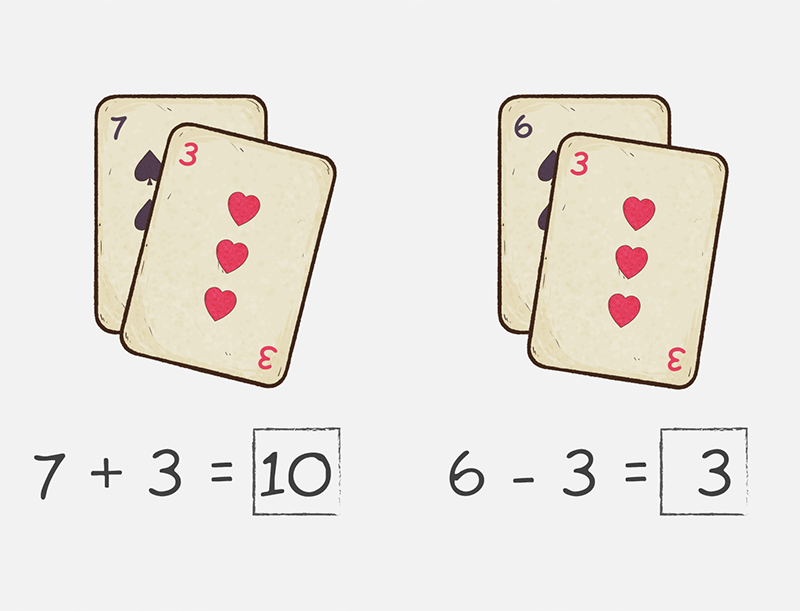
(This is a variation of the traditional Snap card game and uses one deck of cards)
You can find the standard Snap rules at https://bicyclecards.com/how-to-play/snap/.
In this version, the player calls 'snap' when the top two cards add up to ten, or when there is a difference of three between the cards.
You can adapt the rules to suit whatever addition or subtraction numbers that you want your child to practice.
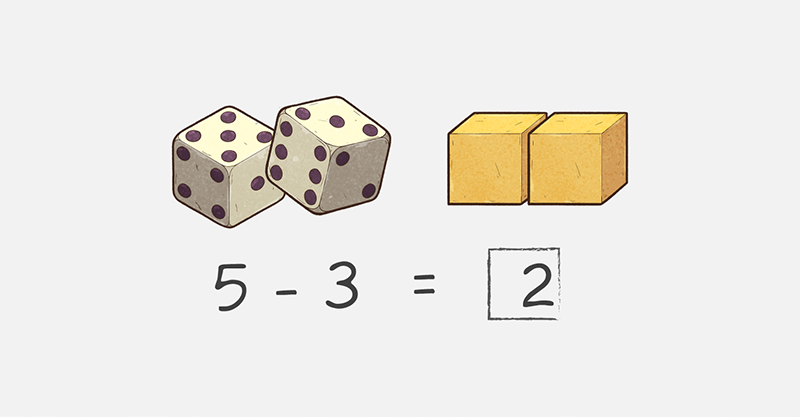
Difference trains
(This uses two dice & blocks, coins or dominoes)
In this game, each player rolls two dice and finds the difference of the numbers rolled, then takes the number of blocks (or coins/dominoes) that is the difference to start their 'difference train'. For example, your child has just rolled 5 and 3 and works out that the difference is 2. Your child then takes 2 blocks to start the train.
Repeat, swapping roles. The winner is the person who has created the longest train and who can also identify the winning difference.
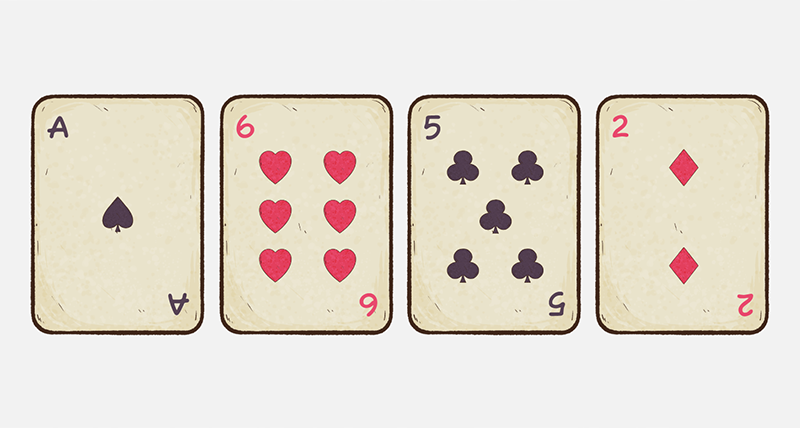
Find a way to make 10
(This game uses one deck of cards, with face cards removed and the Ace = 1)
Deal out the deck of cards evenly to all the players. Each player flips over four cards face up from their own pile.
Players aim to make ten with their cards using addition, subtraction, or a combination of both to end up with 'ten'.
When all the players have done this, they remove these cards and flip over four more cards and try to make ten again. Keep playing until they have no cards left.
The winner is the player who has the most 'tens' when all the cards are used up.
Years 3-4
5 Up
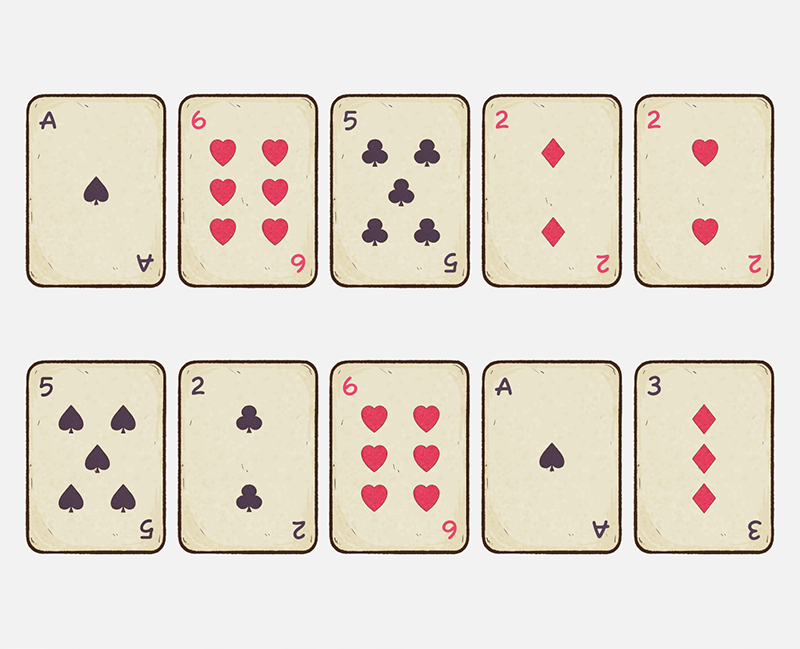
(This uses one deck of cards, with face cards removed and the Ace = 1)
Shuffle the deck of cards and deal out five cards for you and your child. Put the rest of the deck down in the middle of the table.
Each of you turns over your five cards and attempts to work out the total of the numbers shown on the cards. Numbers can be added up in any order.
Whoever has the highest sum is allowed to turn over the top card on the deck of cards in the middle of the table. The number on that card represents the points scored by that winner for 'winning' the round.
Put all of those cards aside. From the deck deal out five more cards each and repeat for the next round.
The winner is the player who has earned the most points at the completion of all rounds (when all cards are used up from the deck).

Salute
(This uses one deck of cards, face cards removed)
This game is played in groups of three (for example, you, your child, and a sibling or friend). Two people face each other and then draw one card from a pile.
Each person places their card facing outwards on their forehead, without looking at it. They can see their partner's card, but not their own.
The third person adds the two cards together and tells the other two what the total is. Each of the other two take turns to work out what their card is.
Years 5-6
Target number
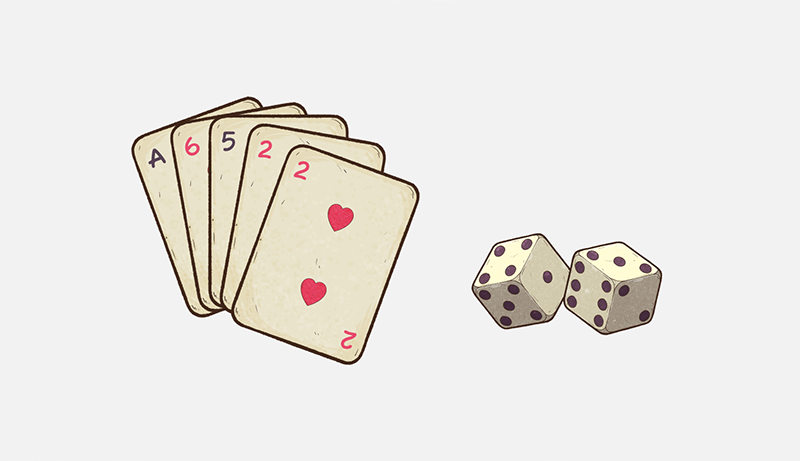
(This uses two dice and one deck of cards)
Use the two dice to create a target number. Roll the first dice - this becomes the 'tens' number. Roll the second one and this becomes the 'ones' number (for example, if you roll a 4 and a 6, your target number is 46).
Deal out five cards to each player. Using as many of these five cards as you can, use addition and subtraction to make a number that gets as close to the target number as you can (for example, if the target number is 46 and a player has these cards: 3,3,4,5,9, then the player could make 94 − 53 + 3 = 44.
Once everyone has come up with their number, everyone shows each other what they have. The person closest to the target number is the winner - they win all the cards in that turn.
Roll the dice again to create a new target number. Then continue to deal out the cards so that each person has five cards again. Once the whole deck has been used up, the person with the most cards at the end wins.
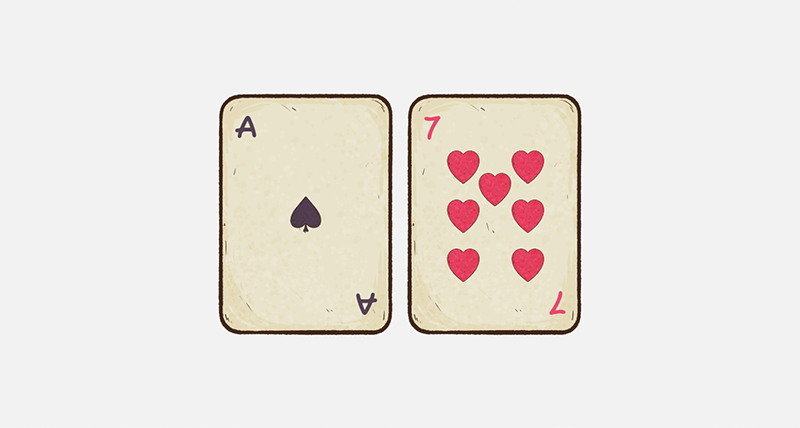
Positive & negative 6
(This uses one deck of cards, with the face cards removed)
Tell all the players that red cards are positive numbers and black cards are negative numbers, and the aim of the game is to make pairs that equal 6 or −6.
Deal six cards to each player and put the rest of the cards face down in a pile. Turn over the top card in the pile and place it next to the pile. This becomes the discard pile.
The player to your left goes first. They take one card from the deck or the discard pile, then try to make a pair (equaling 6 or -6) with the cards they have. If they can make a pair, they put their pairs aside. At the end of their turn, they place a card in the discard pile, and the next person has a turn.
The person to get three pairs is the winner.

Roll the dice
(This uses four dice)
Take turns to roll all four dice. Ask your child to go first and roll the dice to create two 2-digit numbers. Tell them to subtract one number from the other and write down their answer.
Now it is your turn. Roll all four dice and make two 2-digit numbers from them, then subtract one number from the other.
The winner of each round is the one who creates the smallest difference. The winner scores one point. Play ten rounds to determine the overall winner.
Summary
These are just some of the ways you can try using maths with your child at home. Keep thinking about ways to emphasise addition and subtraction skills with your child, and even just trying to do this will help enormously.
